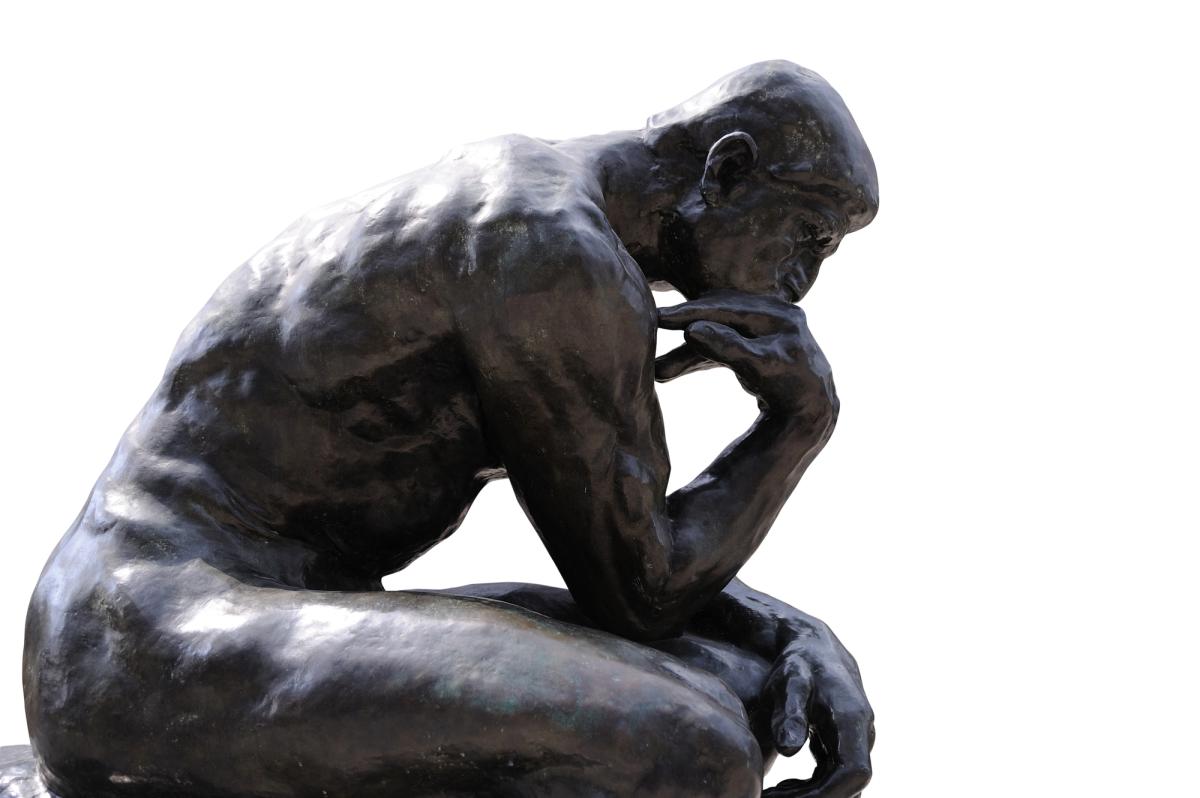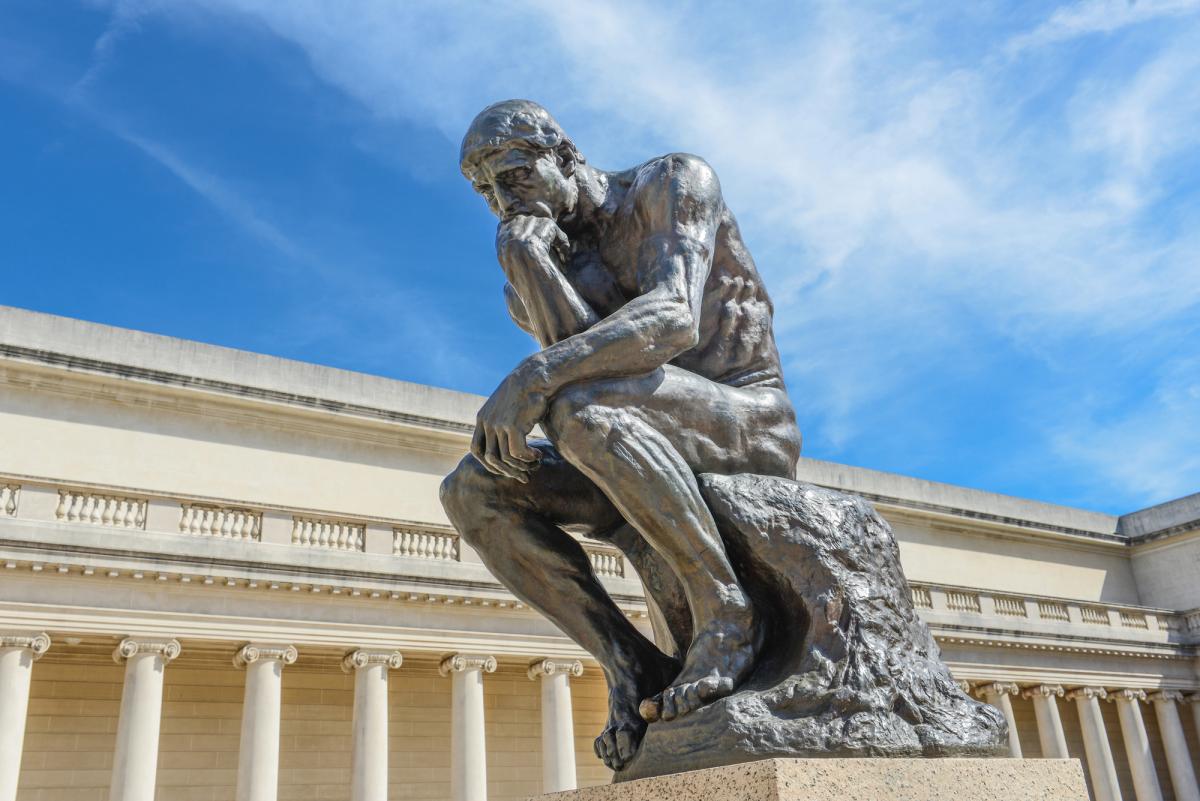The sculpture “The Thinker” is one of the most iconic works by renowned artist Auguste Rodin, one of the most influential sculptors in the history of art.
Rodin, who was born in France in 1840, achieved widespread recognition for his revolutionary contributions to the world of sculpture. He challenged established conventions and explored new expressive possibilities.
“The Thinker” emerged as an iconic representation of human thought, capturing the essence of contemplation and introspection.
Its importance transcends time and space, continuing to resonate in the collective consciousness and inspire generations of artists and admirers.
This Rodin masterpiece not only reflects his artistic genius, but also offers profound insights into the human condition, becoming a timeless symbol of the power of thought and reflection.
Origins and Context
Understanding the origins and context surrounding the creation of the sculpture “The Thinker” by Auguste Rodin is fundamental to fully appreciate his significance in art history.
Here are some important aspects to consider:
History of Auguste Rodin: Before creating “The Thinker”, Rodin had already established his reputation as a visionary sculptor.
Born in France in 1840, he faced early challenges in his career, but eventually gained recognition for his exceptional skill and artistic innovation.
Social context, Political and Artistic: The time when Rodin conceived “The Thinker” was marked by significant changes in society, politics and art.
The end of the 19th century and the beginning of the 20th century were periods of cultural transformation, with the emergence of new ideas and artistic movements, such as impressionism and symbolism.
In addition, social and political issues, such as industrialization and social movements, also influenced the environment in which Rodin worked.
Influences and Inspirations: To create “The Thinker”, Rodin was inspired by several sources, both artistic and philosophical.
His own personal experiences and observations of everyday life also played an important role in the work's conception..
In addition, Rodin was known for studying classical and Renaissance works, as well as engaging with contemporary philosophical ideas, which contributed to the depth and complexity of his creations.
Description and Characteristics of the Sculpture “The Thinker” by Rodin
Upon closely examining the sculpture “The Thinker” by Auguste Rodin, it is possible to observe a series of distinct characteristics that contribute to its uniqueness and impact.
Here, we consider some essential aspects:
Physical description: “The Thinker” is a bronze sculpture depicting a nude man in a pose of deep thought.
With approximately 181 cm tall, the figure stands out for its grandeur and the feeling of contemplation that emanates.
Rodin carefully modeled every detail of the body, from tense muscles to expressive facial features, giving a feeling of life to the work.
Nuances of Pose and Expression: One of the most striking characteristics of “The Thinker” is the character's enigmatic and introspective pose.
With your chin resting on your right hand and your elbow resting on your left thigh, the man seems immersed in deep reveries.
Your facial expression, on the other hand, transmits a mixture of concentration, seriousness and melancholy, inviting the viewer to delve into the protagonist’s reflections.
Comparison with Other Works by Rodin: Although Rodin produced a vast amount of sculptures throughout his career,, “The Thinker” stands out as one of his most emblematic and universally recognized works.
In contrast to other pieces that explore more dynamic and dramatic themes, such as “The Kiss” and “The Gate of Hell”, “The Thinker” is distinguished by its simplicity and its ability to evoke a state of silent and timeless contemplation.

Meaning and Interpretations
When contemplating the sculpture “The Thinker” by Auguste Rodin, it is impossible not to delve into the depths of its symbolic meanings and the reflections it evokes on the human condition.
Here are some important analytics to consider:
Symbolic Meaning: The Thinker is often interpreted as a representation of thought and contemplation.
The character's hunched and introspective posture suggests an individual immersed in deep questions and reflections about life., the universe and your own place in them.
The Thinker becomes, and, a universal symbol of the quest for knowledge and understanding of the world around us.
Philosophical and Psychological Interpretations: Rodin's work raises a variety of philosophical and psychological interpretations.
Some analyzes suggest that The Thinker represents the existential conflict of human beings, while others see in it a representation of the loneliness and isolation inherent to the human condition.
Sign up to receive Event News
and the Universe of Arts first!
In addition, sculpture can be seen as an invitation to self-reflection and self-knowledge, encouraging viewers to explore their own minds and emotions.
Role of Sculpture in the Representation of Thought: Through his masterful depiction of thought and introspection, The Thinker challenges traditional conventions of sculpture by capturing a moment of inner contemplation.
The work transcends its physical form to become a mirror of the human mind, inviting viewers to explore the mysteries of thought and consciousness.
In this sense, The Thinker is not just a sculpture, but a gateway to the realms of the human mind and soul.

Legacy and Cultural Impact
The Thinker, Auguste Rodin's iconic sculpture, left a profound and lasting legacy in art and culture, influencing generations of artists and admirers over the years.
Here are some important aspects to consider:
Impact on Art and Culture: Since its creation, The Thinker has been recognized as one of the most emblematic works of Western sculpture.
His powerful and introspective depiction of human thought has inspired artists across diverse disciplines, including painting, literature and music.
In addition, sculpture influenced important artistic movements, such as expressionism and surrealism, that sought to explore the deeper aspects of the human experience.
References in the Media and Popular Culture: The Thinker has become a globally recognized symbol, appearing in a variety of contexts in the media and popular culture.
From book and film covers to corporate logos and advertisements, Rodin's sculpture continues to be a source of inspiration and reference for artists and creatives around the world.
Perpetuity and Continuous Relevance: Despite being created more than a century ago, The Thinker maintains its relevance and meaning to this day.
Its message about the importance of critical thinking and introspection resonates with people of all cultures and eras, making it an enduring symbol of human potential.
As such, sculpture continues to be studied, appreciated and reinterpreted by those who seek to understand the mysteries of the human mind and soul.
Conclusion: Reflections on the Thinker: An Invitation to Exploration and Contemplation
When reflecting on the various aspects that involve “The Thinker” by Auguste Rodin, the depth and lasting importance of this masterpiece of sculpture becomes evident.
Here is a recap of the main points discussed:
Cultural and Artistic Importance: “The Thinker” It's not just a sculpture, but a cultural icon that transcends the boundaries of time and space.
Its powerful representation of human thought resonates with people of all cultures and generations, becoming a universal symbol of the search for knowledge and understanding.
Ongoing Relevance: Even after more than a century since its creation, “The Thinker” maintains its relevance and impact, continuing to inspire artists, intellectuals and admirers around the world.
His message about the importance of introspection and critical reflection remains as relevant today as it was in Rodin's time..
Invitation to Exploration: We conclude this text with an invitation to readers to continue exploring and reflecting on the richness of Auguste Rodin's sculpture and work..
That “The Thinker” serve as a source of inspiration and contemplation, encouraging us to seek a deeper understanding of ourselves and the world around us.




It's the power of a masterpiece “without life” How about art in its extraordinary conception, is able to “create life” to human perception in all our subtlest senses, wide and deep!!!…
Hello, Aloysio! What beautiful words to describe the impact of art, especially when it comes to a masterpiece like “The Thinker” by Rodin. It's truly amazing how a sculpture can transcend its physical form and come to life in our minds and hearts., awakening our most subtle and deep senses. É como se a obra de arte tivesse o poder mágico de nos conectar a emoções e pensamentos que nem mesmo sabíamos que tínhamos. Obrigada por compartilhar sua reflexão conosco! Que a arte continue a nos inspirar e nos fazer enxergar o mundo com olhos renovados. 😊🎨